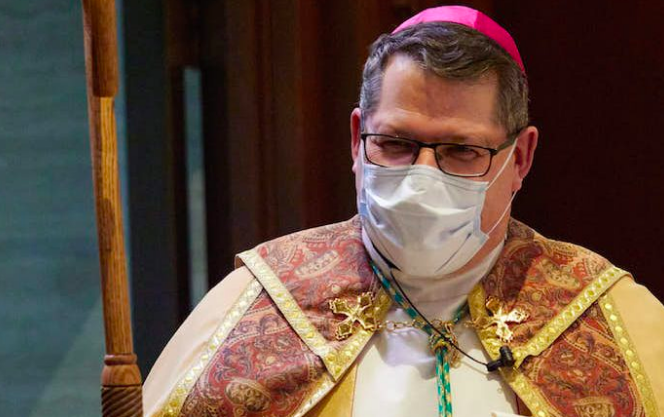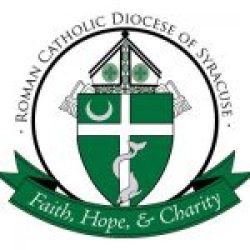Bishop Douglas J. Lucia wears a face mask as he prepares to celebrate a Holy Hour at the Cathedral of the Immaculate Conception May 3. (Sun photo | Chuck Wainwright)
By Renée K. Gadoua | Contributing writer, and Katherine Long | Editor
Bishop Douglas J. Lucia today released protocols for sanitizing, social distancing, and crowd size as he approved resumption of public Masses in the Syracuse Diocese beginning May 30 and 31, the Solemnity of Pentecost.
Celebration of public Masses will be permitted in churches with no more than 10 people, or in church parking lots at 50% capacity, with attendees remaining in their vehicles. Pastors must complete and submit to the bishop’s office a detailed, 16-point form before they resume public Masses.
Dispensation from the obligation to attend weekly Mass continues.
“Thank you for your patience and understanding as we have traveled and continue to travel in uncharted waters!” Bishop Lucia wrote in a letter to the faithful dated May 22.
A 10-page document, “Instructions for the Celebration of the Sacraments When Public Gatherings Resume,” spells out the diocese’s rules. A diocesan task force has been working since early May to develop these policies. Members have reviewed plans from other dioceses and recommendations from the Thomistic Institute and the Federation of Diocesan Liturgical Commissions. They also reviewed documents from the Centers for Disease Control and Prevention (CDC) and local, state, and federal officials.
“Given the nature of the COVID-19 pandemic as well as the various restrictions and precautions that must be in place in order to ensure the health and safety of all, these instructions are intended for expanding access to the sacraments within the current medical and governmental regulations and recommendations,” the Instructions say. “They are subject to change as access to the sacraments may either expand or retract depending on the spread of contagion. Therefore, patience and flexibility on the part of all is required.”
Public Masses in the seven-county diocese have been suspended since March 16, all 22 diocesan Catholic schools were closed by March 18, and New York has been under stay-at-home orders since March 22 as the coronavirus pandemic spread. Most regions of the state, including Central New York and the Southern Tier, were allowed this week to begin resuming some business operations, with restrictions.
Bishop Lucia said in a May 20 email to diocesan staff that he was likely to approve reinstating public Masses on Pentecost. Celebrated 50 days after Easter, Pentecost commemorates the Holy Spirit’s descent upon the Apostles and other followers of Jesus Christ while in Jerusalem celebrating the Feast of Weeks. “When the time for Pentecost was fulfilled, they were all in one place together,” reads a passage from the Acts of the Apostles. After driving wind and tongues of fire, “they were all filled with the holy Spirit and began to speak in different tongues, as the Spirit enabled them to proclaim” (Acts 2:1–31).
New rules for the ‘new normal’
The bishop warns clergy and the faithful that they will experience Mass and other worship services very differently as churches follow procedures intended to prevent spreading the novel coronavirus. “Both the Diocese of Syracuse and each parish have a responsibility to provide a safe worship space for the faithful by adhering to all Federal, State and local governmental and public health guidance aimed at limiting the spread of the virus,” the planning form notes.
Protocols stipulate general principles all parishes must follow: the time spent in gatherings is to be kept to a minimum; the number of individuals allowed to gather must be in compliance with current governmental restrictions; social distancing of 6 feet of separation is to be observed; churches are to be properly disinfected and ventilated before and after each individual use; and all non-sacramental gatherings, particularly congregating before or after Mass either in the church or in the parking lot, are prohibited.
The protocols provide sacrament-by-sacrament breakdowns that include “some mandates, some recommendations, and some reminders,” said Father Christopher Seibt, director of the Office of Liturgy and a member of the diocesan task force.
Among the specific protocols required for the celebration of Mass and the distribution of the Holy Eucharist are the following:
• A system of registration is to be devised to ensure individuals are not turned away at the door, to avoid any traffic issues, and as a safety measure to assist in reporting any possible exposure to COVID-19.
• For Masses in parking lots, parishes must mark traffic routes and parking spots, create a worthy area for celebrating Mass, and provide a sound amplification system. Communicants will be directed to exit their vehicles one vehicle at a time to receive Holy Communion.
• For Masses inside churches, one entrance will be open to registered attendees. Face masks must be worn by attendees over the age of 2. Holy water fonts will be empty and hymnals removed. Pews will be marked for seating; households may sit together. Choirs are suspended but music may be provided by a musician and cantor. To maintain social distancing between both liturgical ministers and the assembly, the route for the entrance procession and the arrangement of the sanctuary may be altered. Collection baskets will be centrally located. Parishioners will not bring the gifts forward. The sign of peace is omitted, as are the non-liturgical practices of holding hands during the Lord’s Prayer and of blessing those who come forward for the reception of Holy Communion, but do not receive.
• During small indoor Masses, only the priest and deacon are to distribute Holy Communion; during large gatherings, Extraordinary Ministers of Holy Communion may assist.
• Masks must be worn by all — clergy, ministers, and the faithful — during the distribution of Holy Communion.
• To receive Communion, the faithful will sanitize their hands and come forward at the direction of the usher. Communicants are strongly recommended to receive Holy Communion in the hand. After receiving the Eucharist, they step aside 6 feet to lift their mask with one hand and consume the Host with the other. Those receiving on the tongue should wait until the end of the line to come forward and remove their mask only at the moment of reception. The Precious Blood will not be distributed.
Pastoral care continues
Not every parish will be able to provide the same access to the sacraments, the Instructions note. Some parishes may not be able to celebrate Mass in parking lots; others may not be able to regulate attendance or properly disinfect spaces. Using the protocols, “each parish must determine what is possible at this time,” the document says. “Only those parishes that can adhere to and enforce these protocols may expand access to the sacraments after submitting the Requirements for the Resumption of Public Worship: Parish Pandemic Form to the Office of the Bishop.”
Further, “All parishes should continue to provide pastoral care in generous, yet responsible ways (e.g., phone calls, letters, streamed liturgies, virtual catechesis, etc.),” it says. “All parishes should also have a system in place for regular reviews of protocols. Following these instructions will help reduce the possibility of spread of disease; however, the risk cannot be reduced to zero.”
Bishop Lucia’s daily 12:10 p.m. Mass at the Cathedral will continue to livestream at youtube.com/syrdio.
Clarifying comments on reopening
As the diocesan task force was finalizing its procedures Friday, President Donald Trump called on governors to allow churches to reopen this weekend. In California, more than 1,200 pastors say they will defy the state’s order and resume in-person services this weekend.
New York Gov. Andrew Cuomo this week said religious gatherings of no more than 10 people — following strict social distancing guidelines — and drive-in and parking lot religious services would be allowed statewide beginning May 21.
“We in the Diocese of Syracuse are anxious to return to public worship, celebrating Mass and the other sacraments,” Bishop Lucia said Friday. “However, we will do so in a way that will keep people safe and healthy. We are awaiting further clarifications of what today’s announcement means; however, we were already planning to release protocols for public worship to begin on Pentecost, next weekend.”
Onondaga County Executive Ryan McMahon said during a May 22 briefing that the county needs clarification on Trump’s comments about reopening churches.”That’s something we need to get a grip on quickly because there’s conflicting guidance between the state and federal government,” he said.
He said New York’s four-phase plan, which allows for larger crowds in each phase, makes sense for houses of worship. ”Going from zero to full capacity probably isn’t the smartest thing to do,” he said. “We need to do it in a safe way where there’s really good communication.”
Clarity would help because “No one is going to want to go into a church during a prayer service and enforce social distancing,” he said.
Some Catholic dioceses across the United States have resumed public Masses in recent weeks. But the vast majority of Americans remain wary of returning to normal activities. A May AP-NORC poll found that 54% of Americans say local restrictions are about right to prevent spreading the coronavirus, which causes COVID-19. That’s down from 61% in April. The poll also found that 18% think restrictions go too far and 27% say they don’t go far enough.
In several cases, churches resumed worship services then closed again after church members or clergy tested positive for COVID-19, the disease caused by the virus.
The Archdiocese of New York on May 21 announced a five-step phase-in “that will seek to move gradually and safely toward a return to the availability of the sacraments and, ultimately Sunday Mass attendance, with a limited capacity,” Catholic New York, newspaper of the Archdiocese of New York, reported. The archdiocese’s final phase includes Celebration of Sunday Mass with supervised attendance of approximately 25% of the church’s permitted occupancy.
Cardinal Timothy M. Dolan said the archdiocese and its parishes have “a moral imperative to protect the health of our people and the wider community. We have been doing that … and we will continue doing that. We also have a responsibility to care for the hearts and souls of our people.”
This story will be updated.







